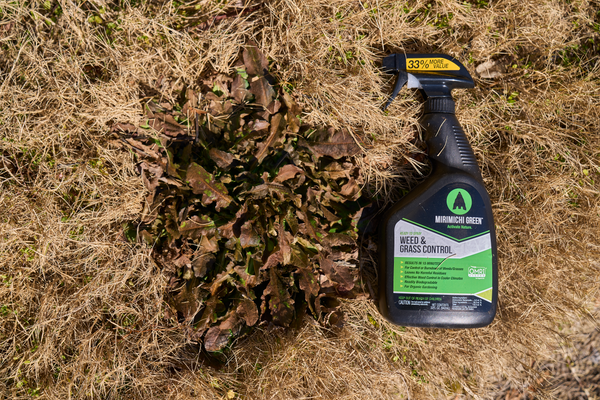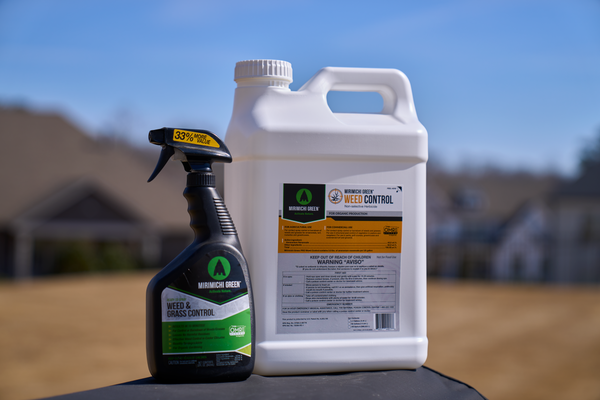How to Maintain an Eco-Friendly Lawn
Table of Contents
- Why Is a Healthy Lawn Important?
- Understanding Your Lawn
- Smart Water Management
- Natural Lawn Fertilization
- Our Top Recommended Organic Fertilizers and Biostimulants to Use on Your Lawn
- Defend Your Turf with Integrated Pest Management (IPM)
- Mowing Techniques for Healthier Lawns
- Aeration and Soil Health
- Natural Weed Control
- A Greener Future for Your Lawn
In recent years, the search for sustainability has spread to places you might not expect, like your lawn. The traditional approaches to having a lush, green lawn have grown to include a broader commitment to accomplishing this goal in a responsible way.
Conventional lawn care practices have often relied on synthetic fertilizers and pesticides to achieve rapid growth and a pristine appearance. If not used correctly, these practices can lead to environmental issues, such as nutrient runoff into water bodies, soil degradation, and harm to beneficial insects and wildlife. Additionally, excessive irrigation can strain local water supplies, especially in drought-prone areas like the south central United States.
The good news is that you can achieve a vibrant and inviting lawn while minimizing the negative impact on the environment. By adopting sustainable and eco-friendly lawn practices, you can contribute to the health of your lawn and the broader ecosystem. In this article, we’ll look at a wide range of strategies, techniques, and products that promote a thriving lawn through organic processes and eco-friendly choices.
Why Is a Healthy Lawn Important?
Having a lush, healthy lawn is not just about how it looks; it offers many other benefits too. It helps keep the air clean, prevents soil erosion, and even cools down urban areas naturally. Well-kept grass gives kids a safe place to play, gets them outside and active, and even boosts the value of your property. So there are plenty of good reasons to keep your lawn in good shape. But how do you do that without heavy reliance on synthetic fertilizers or pesticides? Let’s find out.
Understanding Your Lawn
First of all, get to know your lawn well. Every lawn is different, influenced by factors like soil type, climate, and the type of grass you have. By getting to know these aspects, you'll be more prepared to make wise choices that help keep your lawn healthy and looking great.
Soil Analysis and Its Role in Lawn Health
Having healthy soil is essential if you want your lawn to thrive. A soil test provides beneficial information about your soil, like the pH level, nutrient levels, and composition. This information helps you customize your lawn care program based on what your soil needs. If you focus on fixing any issues with the soil using organic amendments and fertilizers, you can create an excellent environment for your grass to grow naturally.
Recognizing Local Climate Conditions
Having a good grasp of your local climate patterns is essential when making informed choices about lawn care. Is your region prone to drought, heavy rainfall, or extreme temperatures? By familiarizing yourself with climate trends, you can adjust your watering schedule, choose grass varieties resistant to drought, and employ weather-appropriate cultural practices. This knowledge allows you to create a program that allows your lawn to thrive despite adverse conditions.
Choosing the Right Type of Grass for Your Region
Selecting the appropriate grass species for your region is crucial for successful lawn care. Different grass varieties thrive in different climates and soil conditions. Research the grass types that are native or well-adapted to your area, as they often require less water and maintenance. Planting the right grass will ensure that your lawn is resilient to local weather fluctuations and requires less intervention to stay healthy.
Smart Water Management

Water is a precious and expensive resource, and how you manage it in your lawn care program can significantly impact the environment and your utility bills. By adopting efficient watering practices, you can maintain a healthy lawn despite local watering restrictions.
Efficient Watering Schedules and Timing
Establishing a consistent watering schedule is essential for lawn health. Watering early in the morning or late in the afternoon reduces water loss due to evaporation and allows grass blades to dry before nightfall, preventing conditions ideal for fungal growth. Water deeply but infrequently to encourage deep root growth, making your lawn more resilient to drought conditions.
Importance of Avoiding Overwatering and Water Waste
Overwatering can lead to shallow root systems, making your lawn susceptible to drought and disease. Use the "footprint test" to determine if your lawn needs water — if the grass blades don't spring back up after walking on them, it's time to water. Additionally, fix any leaks or broken sprinklers promptly to prevent water waste.
Related reading: How Often Should I Water My Lawn?
Natural Lawn Fertilization

Fertilization is essential for providing your lawn with the necessary nutrients to thrive. However, the type of fertilizer you use and how you apply it can impact the environment and your wallet. Embracing natural fertilization methods can help you maintain a vibrant lawn while minimizing the adverse ecological effects that can be associated with some synthetic alternatives.
Benefits of Organic Fertilizers over Synthetic Alternatives
Synthetic fertilizers opened the door to higher crop output and productivity at the start of the 20th century.
Organic fertilizers, derived from natural sources like compost, manure, and plant materials, offer numerous advantages over synthetic fertilizers. They release nutrients slowly, providing a consistent supply to your lawn while reducing the risk of burning. Organic fertilizers can also improve soil structure, enhance microbial activity, and increase water retention, resulting in healthier and more resilient grass.
Compared to their synthetic counterparts, organic fertilizers take a little longer to start working but can still produce great results if you’re willing to be patient.
Composting as a Source of Nutrient-Rich Soil Amendments
Creating a composting system at home reduces organic waste and provides a nutrient-rich soil amendment. Incorporating compost into your lawn helps enrich the soil with essential nutrients, improves water-holding capacity, and encourages beneficial microorganisms. Compost offers a sustainable and natural way to feed your lawn.
Topdressing and Mulching for Improved Soil Structure
Topdressing your lawn with a thin layer of compost or well-aged manure can enhance soil health. This practice improves soil structure, increases microbial activity, and encourages deep root growth. Mulching your grass clippings instead of collecting and disposing of them returns valuable nutrients to the soil, acting as a natural fertilizer. Both practices contribute to a more sustainable nutrient cycle within your lawn.
Timing and Application Techniques
Just as precision is vital in golf course maintenance, timing and application techniques matter in residential lawn care. Apply fertilizers during the growing season, when the grass can actively absorb nutrients. Avoid over-fertilization, which can lead to nutrient runoff, wastes money, and potentially harms local water bodies. Following recommended application rates and guidelines ensure effective fertilization.
Grass Clippings as Natural Fertilizer
Grass clippings, often considered waste, can be a valuable natural fertilizer when appropriately managed. Mulching, the practice of leaving grass clippings on the lawn after mowing, returns nutrients back to the soil. These clippings decompose, releasing nitrogen and other nutrients that nourish the grass and reduce the need for external fertilization.
Related reading: The Best Types of Organic Fertilizers for Your Lawn
Our Top Recommended Organic Fertilizers and Biostimulants to Use on Your Lawn
Mirimichi Green Organic Lawn Fertilizer and Biostimulant
Mirimichi Green fertilizer also adds beneficial fungi and bacteria to the soil. This infusion improves the soil's quality, makes it easier for nutrients to be absorbed, and improves your grass's general health.
Mirimichi Green Release 901C™
Liquid fertilizer options are available to complete your lawn nutrient program. We highly recommend Mirimichi Green Release 901C, a fertilizer variant of Release Zero. This unique blend gives your grass the macronutrients, carbon, and minerals it needs to grow strong and healthy.
Release 901C™ is unique because it is a liquid lawn fertilizer and a biostimulant. With 9% nitrogen, it gives your grass a dark green color, while 1% potassium makes your grass more resistant to stress. With a good balance of macro and micronutrients, Release 901C™ also has 10% liquid carbon to strengthen grass roots, improve water retention, and aerate the soil. This fertilizer and biostimulant will enhance the performance of other turf maintenance products and is a highly effective liquid lawn fertilizer choice.
CarbonizPN-G™ Granular Soil Compost and Biochar
CarbonizPN-G is an innovative product combining granular soil compost and biochar to elevate soil health and support sustainable lawn practices. This dynamic blend enhances soil structure, water retention, nutrient availability, and plant vitality. By seamlessly integrating organic compost, biochar, and other ingredients, CarbonizPN-G nurtures resilient and eco-friendly landscapes. Its straightforward application makes it a valuable tool for cultivating healthier soil and vibrant plants in gardens, flower beds, lawns, and landscaping projects.
We recommend you use this before applying granular or liquid fertilizer.
Defend Your Turf with Integrated Pest Management (IPM)

A flourishing lawn requires protection against pests and diseases, but traditional methods involving certain pesticides can harm beneficial insects, soil health, and the environment at large. Integrated Pest Management (IPM) offers a holistic approach focusing on prevention and minimal intervention, reducing the need for pesticides while keeping your lawn healthy.
Related Reading: A Sustainable and Holistic Approach to Lawn Care
Identifying Common Lawn Pests and Diseases
Learn to recognize common pests and diseases that can affect your lawn. Keep an eye out for signs of infestation, such as discolored patches, wilting, or unusual growth patterns. Early detection allows for prompt and targeted action, reducing the need for extensive curative treatments.
Encouraging Natural Predators and Beneficial Insects
Many insects are beneficial for your lawn as they prey on harmful pests. Encourage the presence of these natural predators by avoiding broad-spectrum pesticides that can harm them. Ladybugs, lacewings, and predatory nematodes are beneficial insects that help control pest populations.
Using Eco-Friendly Pest Control Methods and Homemade Remedies
If pest problems arise, explore eco-friendly solutions.. Neem oil, diatomaceous earth, and garlic-based sprays are examples of natural pest repellents. Additionally, homemade remedies like soap-water solutions can help deter pests.
Our favorite organic pest control product to use on your lawn is Mirimichi Green Pest Control. It employs natural and non-toxic ingredients to control pests. This reduces the risk of harm to beneficial insects, pets, and the environment.
It targets specific pest issues while avoiding broad-spectrum pesticides that could harm non-target organisms. Despite its non-toxic nature, this pest control solution delivers effective results.
Related reading: Pest Control For Your Lawn | A Complete Guide
Mowing Techniques for Healthier Lawns

Mowing is a fundamental aspect of lawn care, and how you approach it can significantly influence the health and appearance of your lawn. Sustainable mowing practices maintain a neat and attractive lawn and contribute to its overall well-being and the environment.
Setting the Right Mowing Height for Your Grass Type
Different grass species have optimal mowing heights that promote healthy growth. Cutting your grass too short can stress the plants, making them more susceptible to pests and diseases. Research the recommended height for your grass type and adjust your mower accordingly.
Regular Mowing and Grass Clippings as Natural Mulch
Establishing a regular mowing schedule prevents your lawn from becoming overgrown, which can lead to uneven growth and reduced sunlight penetration. Consider leaving grass clippings on the lawn after mowing — they act as natural mulch, returning nutrients to the soil as they decompose and reducing the need for additional fertilization.
Alternating Mowing Patterns
Just as golf courses employ alternating mowing patterns to prevent soil compaction and ensure even wear, homeowners can apply this technique to their lawns. Mowing in different directions with each session prevents the grass from leaning in one direction and encourages upright growth. It also minimizes soil compaction caused by repetitive mower tracks.
Maintaining Sharp Mower Blades for Clean Cuts
Dull mower blades tear the grass instead of cleanly cutting it. This stresses the grass and creates an entry point for diseases. Regularly sharpen your mower blades to ensure a clean cut, promoting healthier grass growth and reducing the risk of damage.
Aeration and Soil Health

Aeration is vital for maintaining healthy soil and ensuring the efficient exchange of nutrients and air between the soil and the grass roots. By implementing proper aeration techniques, you can enhance the overall health of your lawn and contribute to a sustainable lawn care routine.
Understanding the Importance of Aeration
Over time, soil compaction can occur due to foot traffic, heavy equipment, and natural settling. Compacted soil restricts the movement of water, air, and nutrients, hindering the growth of grass roots. Aeration is the process of punching small holes in the soil. This reduces compaction and improve soil structure.
Core Aeration and Its Benefits for Nutrient and Water Absorption
Core aeration is a technique that removes small plugs of soil from the lawn. This process creates space for air, water, and nutrients to penetrate the soil and reach the roots more effectively. As a result, grass roots grow deeper, leading to a stronger and more resilient lawn that requires less frequent watering.
Timing and Frequency of Aeration
Golf courses practice aeration at specific times of the year, typically during the growing season. Homeowners should aim for the same timing, preferably in the early spring or fall when the grass is actively growing. Avoid aerating during extreme heat or drought conditions, as the grass may struggle to recover.
Overseeding to Enhance Lawn Density and Health
After aeration, consider overseeding your cool-season lawn with appropriate grass varieties. Overseeding helps fill in bare patches, improves the density of the grass, and enhances its overall appearance..
Related reading: How to Core Aerate Your Lawn
Natural Weed Control

Weeds are a common challenge in lawn care, and addressing them in an environmentally friendly manner is crucial for maintaining a healthy ecosystem. By adopting responsible weed management practices, you can keep your lawn looking its best while minimizing the need for synthetic herbicides.
Preventive Measures for Weed Control
The best defense against weeds is a healthy lawn. Encourage dense grass growth by following proper watering, fertilization, and mowing practices. A dense lawn shades the soil, preventing weed seeds from germinating and establishing themselves.
Hand-Pulling and Manual Weed Removal
For smaller infestations, consider hand-pulling weeds. Ensure that you remove the entire root to prevent regrowth. Hand weeding tools can make this process more effective. Regularly inspect your lawn for new weeds and address them promptly.
Natural Herbicides and Eco-Friendly Lawn Weed Management Products
While effective, most natural herbicides are non-selective in nature. This means they will injure or kill any plant they’re applied to. These products are often derived from natural ingredients and break down more quickly. Always read labels carefully and limit application to only the weeds being targeted.
There is a product by Mirimichi Green that we highly recommend for organically controlling weeds. The primary ingredient in Mirimichi Green Organic Weed Control is ammonium nonanoate, which is similar in composition to soap salts. It is safe to use around people, pets, and livestock when used as directed. Ammonium nonanoate is also biodegradable, breaking down quickly in the soil, so there’s no chance for buildup or runoff.
It is a post-emergent herbicide, meaning it will only kill weeds on contact that are already growing; it won’t prevent them. It’s a non-selective weedkiller, so it will kill any plant it's applied to — you must be careful to isolate only the weeds you want to kill and not spray it on your lawn.

Related reading: How To Kill Weeds Naturally | Golf Course Lawn Store
A Greener Future for Your Lawn
In the pursuit of a lush and vibrant lawn, homeowners have the opportunity to make a positive impact on the environment. By adopting eco-friendly lawn practices, you can create an outdoor space that is both visually appealing and ecologically responsible.
To improve the quality of your soil, discover Mirimichi Green’s eco-friendly range of biostimulants and fertilizers for your lawn.
